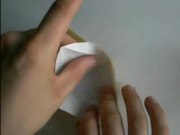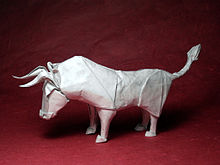Origami
![]()
This article is about the art of paper folding; for the band of the same name, see Origami (band).
Origami ([oʀiˈɡaːmi], ![]() ) (Japanese
) (Japanese ![]() [ˈoriˌɡami]; from oru for "fold" and kami for "paper") is the art of paper folding. Starting from a mostly square sheet of paper, two- or three-dimensional objects such as animals, paper planes, objects and geometric bodies are created by folding.
[ˈoriˌɡami]; from oru for "fold" and kami for "paper") is the art of paper folding. Starting from a mostly square sheet of paper, two- or three-dimensional objects such as animals, paper planes, objects and geometric bodies are created by folding.

Traditional crane

Play media file A crane is folded
Conditions for a two-dimensional origami object
For a model to be flat or level when folded, the associated folding plan must satisfy the following conditions:
- The number of all folds must be even.
- It must be
or
(
= mountain fold,
= valley fold; Mackawa/Justin).
- The local minimum of a wedge must lie between a mountain fold and a valley fold
- When calculating the fold degrees, the result must be 0°. Example with four folds:
.
- The different folds (in a quad node) must face each other in this constellation:
and
. This means that is
a mountain fold and is
a valley fold, for example, while
and
are both mountain folds.
Parts of the origami
Today, origami is divided into several different directions, which can also be mixed with each other.
- Classic origami: a paper, usually square
- Modular Origami (sometimes called Tangrami): Several identical parts are put together to form a model, such as:
· Box pleats (a luminary in this field is Tomoko Fuse).
· Polyhedra: Here, different parts are sometimes used (e.g. connectors and faces).
· Tangrami: also known as 3D origami, is especially widespread in China, where a large number of mostly similar modules are put together to form different models.
- Multipiece Origami: Different parts are put together to form dolls and the like (often with the use of glue).
- Boxpleating: By folding horizontal and vertical lines that change direction along 45-degree angles, it is possible to obtain any number of free layers that can then be shaped into all sorts of legs, arms, and so on.
- Iso Area: The finished model looks the same from all sides.
- Pureland: Only mountain-and-valley folds (the basic folds in origami) may be used.
- Tessellations (from the English of mosaic): flat folding pictures with repeating patterns.
- Wetfolding: The folding of slightly moistened paper to better shape models. The finished (dried) models are very stable and appear more lifelike. Some folders use very firm paper such as elephant skin or watercolor paper for this, while others use extremely thin tissue paper or similar paper that has previously been treated with methyl cellulose (wallpaper paste) to make it more malleable.
- Kirigami: folds with incisions
- Crumpling: A folding method made famous by the Frenchman Vincent Floderer. First, a certain "base" is folded, which is then specifically crumpled and carefully brought into shape.
- Kinetic Origami: Spirals are created that can be twisted at will.

A bull (wet folding example)
_of_an_elephant.jpg)
Elephant from a US dollar
Questions and Answers
Q: What is origami?
A: Origami is a traditional Japanese art of paper folding.
Q: What is origami paper made of?
A: Origami paper is specially made for folding and staying in shape.
Q: What can be created using origami techniques?
A: Various objects can be created using origami techniques.
Q: Can new models and creatures be created using origami?
A: Yes, new models and creatures have been made possible because of new folding techniques.
Q: How did the Japanese first fold origami?
A: When the Japanese first folded origami, they used only one piece of paper.
Q: What is modular origami?
A: Modular origami is a different kind of origami that uses many small pieces that are the same, which are combined to form one large model.
Q: What else can be made using origami?
A: Many mathematical shapes can be made with origami.
Search within the encyclopedia